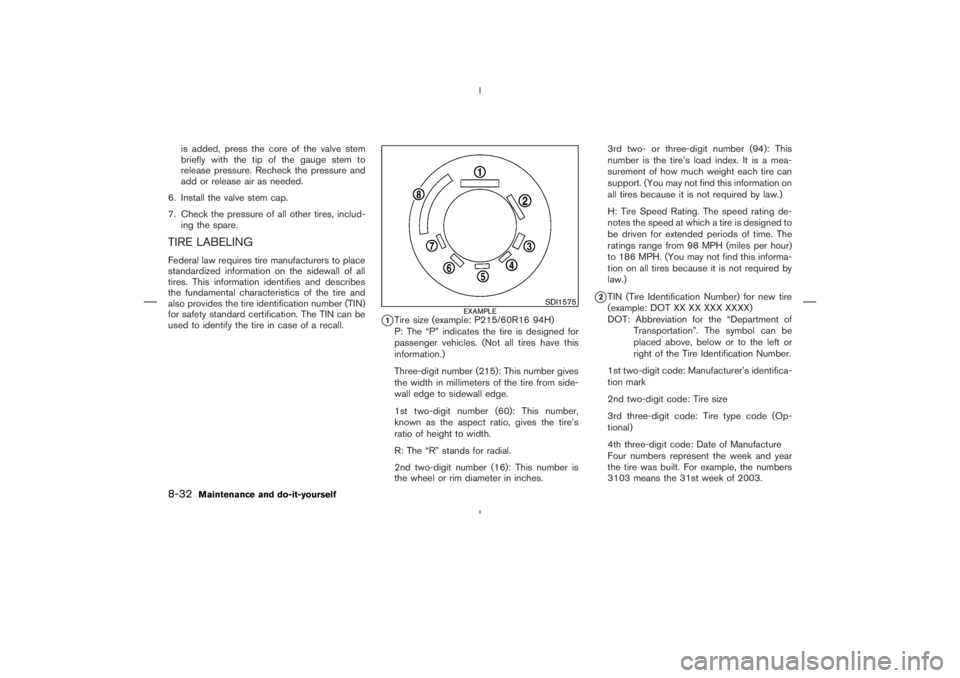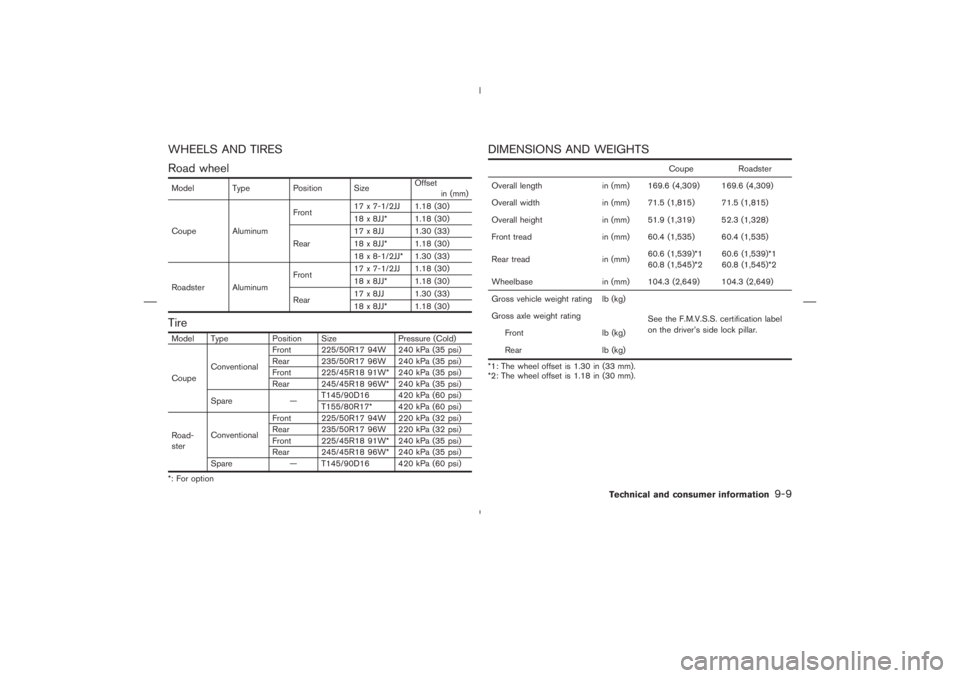Page 221 of 262

is added, press the core of the valve stem
briefly with the tip of the gauge stem to
release pressure. Recheck the pressure and
add or release air as needed.
6. Install the valve stem cap.
7. Check the pressure of all other tires, includ-
ing the spare.
TIRE LABELINGFederal law requires tire manufacturers to place
standardized information on the sidewall of all
tires. This information identifies and describes
the fundamental characteristics of the tire and
also provides the tire identification number (TIN)
for safety standard certification. The TIN can be
used to identify the tire in case of a recall.
�1Tire size (example: P215/60R16 94H)
P: The “P” indicates the tire is designed for
passenger vehicles. (Not all tires have this
information.)
Three-digit number (215): This number gives
the width in millimeters of the tire from side-
wall edge to sidewall edge.
1st two-digit number (60): This number,
known as the aspect ratio, gives the tire’s
ratio of height to width.
R: The “R” stands for radial.
2nd two-digit number (16): This number is
the wheel or rim diameter in inches.3rd two- or three-digit number (94): This
number is the tire’s load index. It is a mea-
surement of how much weight each tire can
support. (You may not find this information on
all tires because it is not required by law.)
H: Tire Speed Rating. The speed rating de-
notes the speed at which a tire is designed to
be driven for extended periods of time. The
ratings range from 98 MPH (miles per hour)
to 186 MPH. (You may not find this informa-
tion on all tires because it is not required by
law.)
�2TIN (Tire Identification Number) for new tire
(example: DOT XX XX XXX XXXX)
DOT: Abbreviation for the “Department of
Transportation”. The symbol can be
placed above, below or to the left or
right of the Tire Identification Number.
1st two-digit code: Manufacturer’s identifica-
tion mark
2nd two-digit code: Tire size
3rd three-digit code: Tire type code (Op-
tional)
4th three-digit code: Date of Manufacture
Four numbers represent the week and year
the tire was built. For example, the numbers
3103 means the 31st week of 2003.
SDI1575
EXAMPLE
8-32
Maintenance and do-it-yourself
�
04.5.17/Z33-D/V5.0
�
Page 236 of 262

WHEELS AND TIRES
Road wheelModel Type Position SizeOffset
in (mm)
Coupe AluminumFront17 x 7-1/2JJ 1.18 (30)
18 x 8JJ* 1.18 (30)
Rear17 x 8JJ 1.30 (33)
18 x 8JJ* 1.18 (30)
18 x 8-1/2JJ* 1.30 (33)
Roadster AluminumFront17 x 7-1/2JJ 1.18 (30)
18 x 8JJ* 1.18 (30)
Rear17 x 8JJ 1.30 (33)
18 x 8JJ* 1.18 (30)TireModel Type Position Size Pressure (Cold)
CoupeConventionalFront 225/50R17 94W 240 kPa (35 psi)
Rear 235/50R17 96W 240 kPa (35 psi)
Front 225/45R18 91W* 240 kPa (35 psi)
Rear 245/45R18 96W* 240 kPa (35 psi)
Spare —T145/90D16 420 kPa (60 psi)
T155/80R17* 420 kPa (60 psi)
Road-
sterConventionalFront 225/50R17 94W 220 kPa (32 psi)
Rear 235/50R17 96W 220 kPa (32 psi)
Front 225/45R18 91W* 240 kPa (35 psi)
Rear 245/45R18 96W* 240 kPa (35 psi)
Spare — T145/90D16 420 kPa (60 psi)
*: For option
DIMENSIONS AND WEIGHTS
Coupe Roadster
Overall length in (mm) 169.6 (4,309) 169.6 (4,309)
Overall width in (mm) 71.5 (1,815) 71.5 (1,815)
Overall height in (mm) 51.9 (1,319) 52.3 (1,328)
Front tread in (mm) 60.4 (1,535) 60.4 (1,535)
Rear tread in (mm)60.6 (1,539)*1
60.8 (1,545)*260.6 (1,539)*1
60.8 (1,545)*2
Wheelbase in (mm) 104.3 (2,649) 104.3 (2,649)
Gross vehicle weight rating lb(kg)
See the F.M.V.S.S. certification label
on the driver’s side lock pillar. Gross axle weight rating
Front lb(kg)
Rear lb(kg)
*1: The wheel offset is 1.30 in (33 mm).
*2: The wheel offset is 1.18 in (30 mm).
Technical and consumer information
9-9
�
04.5.17/Z33-D/V5.0
�
Page 248 of 262

DOT (Department Of Transportation) Quality
Grades: All passenger car tires must conform to
federal safety requirements in addition to these
grades.
Quality grades can be found where applicable
on the tire sidewall between tread shoulder and
maximum section width. For example:
Treadwear 200 Traction AA Temperature ATreadwearTreadwear grade is a comparative rating based
on tire wear rate when tested under controlled
conditions on specified government test
courses. For example, a tire graded 150 would
wear one and a half (1-1/2) times as well on the
government course as a tire graded 100. How-
ever, relative tire performance depends on actual
driving conditions, and may vary significantly
from the norm due to variations in driving habits,
service practices and differences in road char-
acteristics and climate.Traction AA, A, B and CThe traction grades, from highest to lowest, are
AA, A, B, and C. Those grades represent the
tire’s ability to stop on wet pavement as mea-
sured under controlled conditions on specified
government test surfaces of asphalt and con-crete. A tire marked C may have poor traction
performance.
WARNING
The traction grade assigned to your ve-
hicle tires is based on straight-ahead
braking traction tests, and does not in-
clude acceleration, cornering, hydro-
planing, or peak traction characteristics.Temperature A, B and CTemperature grades are A (the highest), B, and
C. They represent a tire’s resistance to heat
build-up, and its ability to dissipate heat when
tested under controlled conditions on a speci-
fied indoor laboratory test wheel. Sustained high
temperature can cause tire material to degener-
ate, reducing tire life. Excessive temperatures
can lead to sudden tire failure. Grade C corre-
sponds to a performance level which all passen-
ger car tires must meet under the Federal Motor
Vehicle Safety Standard No. 109. Grades A and
B represent higher levels of performance on
laboratory test wheels than the minimum re-
quired by law.
WARNING
The temperature grade for this tire is
established for a tire that is properly
inflated and not overloaded. Excessive
speed, underinflation, or excessive
loading, either separately or in combi-
nation, can cause heat buildup and pos-
sible tire failure.
UNIFORM TIRE QUALITY
GRADING
Technical and consumer information
9-21
�
04.5.17/Z33-D/V5.0
�